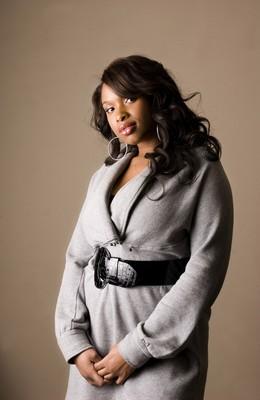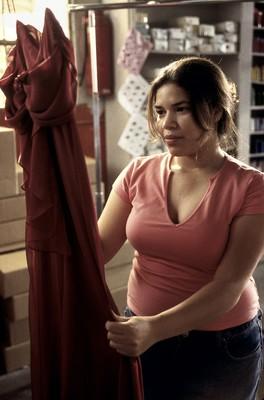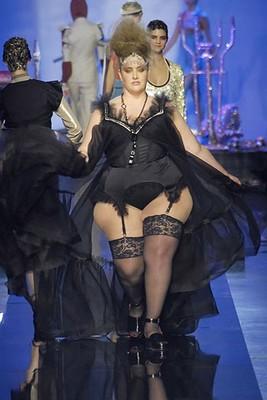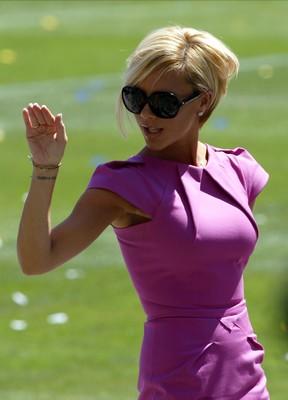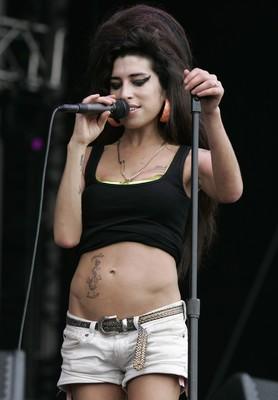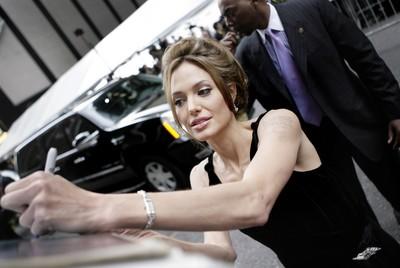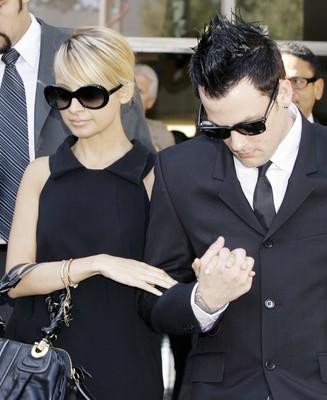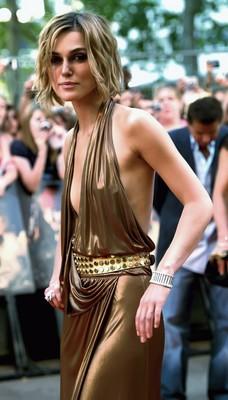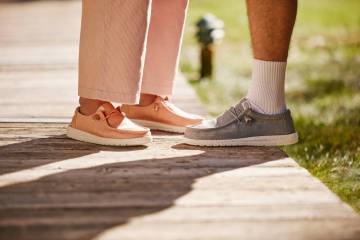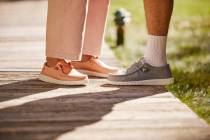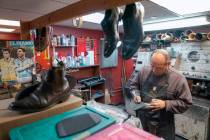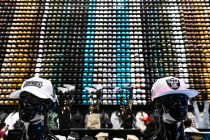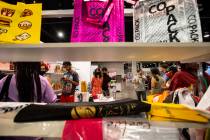WHERE’S THE (BIG) LOVE?
Everyone wants to celebrate the full-figured woman these days from Tyra Banks with her "So What?" challenge, to Dove and its "Real Beauty" campaign; even Hollywood threw its pom-poms up for America Ferrera and Jennifer Hudson this past awards season.
But, commending the curvaceous loses its credibility when the message inevitably gets mixed.
After unflattering pictures of Banks in a black swimsuit surfaced in magazines and on the Web, the former supermodel slapped her butt and told critics to kiss her "fat (expletive)" on the "Tyra Banks Show." This marked the launch of "So What?" a seemingly empowering campaign that challenged women to embrace their physical flaws. A few months later, however, "Life & Style" magazine ran a cover on "How Tyra Lost 30 lbs.!" In a revealing green bikini, Banks' svelte figure looked more "That's what!" than "So What?"
While none of Dove's "Real Beauty" models would be called on for a Victoria's Secret shoot, none look over a size 10, either. Odd, considering Dove says they represent the average woman, who in actuality wears a 14. Adding insult to injury, the product the campaign promotes is a firming cream for cellulite, a common concern among "real women."
Lastly, the two starlets whose curves fashion magazines momentarily cheered, Ferrera and Hudson, started shrinking the minute the limelight was switched on them.
It all begs the question: If fashion models, the beauty industry and Hollywood want to talk the plus-size praising talk, why don't they also walk the walk?
"The support and positive feedback of the proud and plus-size community is meaningful, but it's a lot smaller than the other stuff," said Wendy Shanker, author of "The Fat Girls Guide to Life." The "other stuff" includes congratulations when weight loss allows old jeans to fit again and the newfound attention of the opposite sex when a size goes from double to single digits.
INCREDIBLE SHRINKING WOMEN
Add celebrity to the equation and things get even more confusing. Take Fererra of "Ugly Betty" fame, for instance. In the past year she's served as the unofficial face -- or body, rather-- of the plus-size woman. Celebrities who've done the same before her include model Emme Aronson and actress Camryn Manheim. Put both of them next to Ferrera and it's clear one of these kids is doing their own thing; Ferrera is not plus size.
"I had my hands on (America Ferrera) when 'Real Women Have Curves' came out ... our clothes wouldn't fit her," said Catherine Lippincott, spokesperson for plus-size retailer Lane Bryant. The Golden Globe winner has downsized since the movie debuted in 2002, yet Hollywood and fashion magazines still stamp her with the plus-size label.
Women who were once looked to as plus-size role models, such as Star Jones, make the plus-size concept even more difficult to comprehend. Jones used to proudly tell America she loved her curves and wouldn't change a thing about them when she co-hosted "The View." She even served as the spokesperson for Payless Shoe Source, a shoe retailer known for its large wide-width collection, a feature many plus-size women need. Two weeks ago the "Court TV" talk show host confessed to undergoing gastric bypass surgery to achieve her current size 10 body, down from a size 22. The conflicting words and actions lead the public to think every plus-size woman secretly desires a smaller number on their clothing tags.
BABY STEPS
Local part-time plus-size model Sydni Sayles is runway-strutting proof that's not always the case. The former size 2 model used to drink protein shakes in hopes of going up a few sizes. "I wanted to be an 8 or 10 because I wanted my jeans to fit me like nobody's business," she said.
The shakes didn't add any new shapes to her figure, but two children did. Currently a 14/16, it took Sayles time to accept her new size. It didn't take the modeling industry long, though. She approached Lenz Model & Talent Agency to gauge interest in using her as a plus-size model after seeing a recent ad with large women in bras and panties. The agency enthusiastically accepted, offering Sayles a gig in a lingerie runway show. They liked what they saw. So did Shirley of Hollywood, who called on her to walk its lingerie show and to pose for a catalog shoot in Los Angeles.
Once uncomfortable with her 200 pound, 5-foot-11 frame, the 31-year-old found sporting bustiers, fishnets, thigh-highs and G-strings in front of an audience empowering for her and all plus-size women.
"There was a time in our culture when artists would only paint big women with rolls because that was considered sexy," Sayles said. "We need to return to that thinking."
Some would argue we're well on our way. Eight years ago, Vogue's editor-in-chief, Anna Wintour, told the 5-foot-6 1/2 Oprah Winfrey she'd have to drop down to 150 pounds if she wanted to grace her cover. Winfrey complied, marking the first time a woman over a sample size 2, or very close to it, landed the cover. Fast forward to last March and you have a much different scenario. Wintour cherry-picked Jennifer Hudson, size 12, to be the cover model for an issue thicker than most Vogue model's arms. Hudson shined on the cover in a red Carolina Herrera gown next to the bold-faced cover line "The Power Issue."
Perhaps Wintour took a cue from fashion designer Jean Paul Gaultier, who chose an eyebrow-raising method of showing high fashion praise for high size models. At his 30th anniversary show last October, Gaultier sent Crystal Renn, a size 20 lingerie-clad model, down the runway as his grand finalé. The audience roared with applause.
TOUGH LOVE
While both Wintour and Gaultier have given non-sample sized women a courteous nod, neither have fully integrated them into their fashion regime since. Although the average woman in the United States is approximately 5-foot-4, 160-pounds and a size 14, according to the National Center for Health Statistics, she gets little to no representation in magazines or on runways -- let alone in clothing stores.
Department stores either don't carry plus sizes (Neiman Marcus) or they put them in hard-to-find, hard-to-see locations, implying a shame connected to these shoppers.
According to Lippincott of Lane Bryant, the only shame lies in the retailers' self-deprivation of huge profit potential. "The plus-size woman is the average woman," she said. "And the average woman is interested in fashion and has money to spend on clothes."
But the plus-size woman's shopping motivation goes further than an interest in fashion, it's about famine. As Lippincott explains it, when your options are as limited as the plus-size shopper's, you have a tendency to go overboard when you find something that works out of fear you won't find it again.
If certain department stores, fashion magazines and designers (many carry plus sizes but don't advertise it), want to continue to shun plus sizes, then let them, says "Fat Girl's Guide to Life" author Shanker.
"That's fine because we don't want to play with them, either," she said. Shanker predicts scale tippers everywhere will begin tipping the justice scale, too. Rather than plead for acceptance among mainstream mediums, the author predicts plus sizers will abandon them. She says the future holds a host of new options for plus-size women, by plus-size women, such as new stores, records, TV shows, Web sites and more. "We don't have to try and play with kids who don't want to play with us," she said. "We'll build our own playground!"
plus-size shopping guide This isn't a complete guide to every plus-size outlet known to the curvy woman. Instead, it's a filtered plus-size guide to the stores we recommend. Translation: this is the good stuff. Lane Bryant: If you like the clothes in the malls' non-plus-size chain stores, you'll like it here. Trendy, casual chic gear. Sizes 14-28. Torrid: For the plus-size girl with edge, look for sexy dresses, fishnets and urbanwear here. Sizes 12-26 (Size tags actual start at 0). Ashley Stewart: Focusing on the "urban woman," these clothes carry bold features. Sizes 14-26, with a few 12s. Fashion Bug: You might have to dig a little deeper for up-to-date, modern clothes but the modest prices are worth the trouble. Sizes 14-32. Avenue: A little on the matronly side, this store can be limited in the fashion-forward pieces. Great source for office attire. Sizes 14-32. Macy's: The plus-size department here understands larger sizes need not skimp on style or sex appeal. Sizes 14-24. Nordstrom: Encore has recently stepped up its plus-size inventory, adding Rachel Pally and Paige Premium Denim. Sizes 14-24. Saks Fifth Avenue: Salon Z carries such high-end plus-size designers as Marina Rinaldi, Carmen Marc Valvo and Dana Buchman. Sizes 14-24. Sizeappeal.com: Careful here. Not all the styles keep in mind that fuller figures can't get away with everything stick figures can. Sizes 1X-4X. Kiyonna.com: Expect to spend a little more at this online boutique where sophistication rules. Sizes 12-32. Monifc.com: For the plus-size woman willing to take risks with prints, color and their signature "convertible dress." Sizes 14-24. Igigi.com: Their classy clothes strive to flatter "many specific figure shapes." Sizes 14-32. where's the beef? Call us crazy but we'd much rather see ample cleavage than a sunken in chest; rounded shoulders as opposed to sharp clavicles; shapely hips over boyish builds. You know, real women features. Here are a handful of the celebrities who need to do themselves a favor and "beef" up the skin on those bones. Nicole Richie: Yes, she's sporting a new bump but now she just looks like a malnutritioned orphan in Chanel. Angelina Jolie: If this one doesn't eat something -- and quick -- her lips could soon outweigh her body. Victoria Beckham: Bones and boobs. Amy Winehouse: Looks like she says, "No, no, no!" to rehab -- and food. Keira Knightley: The pirates need look no more; the sunken chest is right here.



